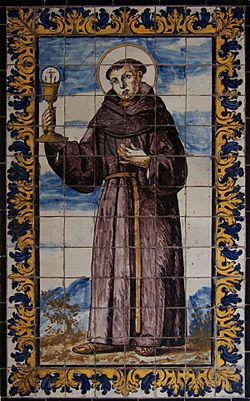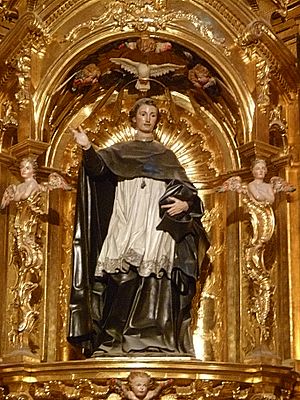John of Sahagún facts for kids
Quick facts for kids St. John of Sahagún, OESA |
|
|---|---|
 |
|
| Born | c. 1430 Sahagún, Province of Leon, Crown of Castile |
| Died | 11 June 1479 (aged 48) Salamanca, Province of Salamanca, Crown of Castile |
| Venerated in | Catholic Church (Order of St. Augustine and Diocese of Salamanca) |
| Beatified | 1601, Rome by Pope Clement VIII |
| Canonized | 16 October 1690, Rome by Pope Alexander VIII |
| Major shrine | Old Cathedral, Salamanca, Spain |
| Feast | 11 June 12 June (General Roman Calendar, 1729-1969) |
| Attributes | Chalice and host |
| Patronage | Candon City Toledo, Cebu |
John of Sahagún (born around 1430 – died June 11, 1479) was a Spanish Augustinian friar and priest. His Spanish name was Juan de Sahagún. He was a very important preacher during his time. People knew him for helping to make peace between fighting groups in the city of Salamanca. The Catholic Church declared him a saint in 1690. This was done by Pope Alexander VIII.
Contents
Life Story
John was born in the year 1419. His hometown was Sahagún in the Province of Leon. He was the oldest of seven children. His family, the González del Castrillo, was quite wealthy.
Early Years and Education
John first studied with monks at the Royal Monastery of St. Benedict. This monastery was a major learning center in the area. When he was young, he became a cleric. His father then helped him get a church position in a nearby town.
Later, he met Alfonso de Cartagena, who was the Bishop of Burgos. The bishop was very impressed by John. He arranged for John to be educated at his own home. John became a priest in 1445. He also became a canon at the Burgos Cathedral.
John felt bad about holding so many church jobs at once. This was against church rules. So, he gave up most of them. He only kept a small job at the Chapel of St. Agatha. There, he said Mass and preached to poor people. He then decided to live a very simple and strict life.
Becoming a Preacher
In 1456, the bishop he knew passed away. John then left his chaplain job. He went to the University of Salamanca to study more. For four years, he studied theology and church law. He earned degrees in both subjects.
During this time, he also worked at a chapel. He was a preacher there for nine years. Many people came to hear him speak. He even criticized the rich and powerful. The Duke of Alba complained about his sermons. John focused on helping people with their spiritual needs.
He became very sick and needed surgery. He promised that if he got better, he would join a religious order.
Joining the Friars
John recovered from his illness in 1463. He then joined the Order of St. Augustine. From that time on, he was known as Brother John. In 1464, he made his official vows to the Order.
His leaders told him to focus on preaching. John was not afraid to speak out against bad behavior. He criticized the rich and powerful in his sermons. This made him many enemies. Some women in Salamanca were angry about his sermons. They even threw stones at him in the streets. Guards had to stop them.
John was later put in charge of new members. In 1471, he became the prior of his community. He led by showing a good example. He also helped with important meetings for the Order.
John especially loved the Blessed Sacrament. He was also known for being able to understand people's hidden thoughts. Because of this, people often asked him to help settle arguments. He helped bring peace to the city. He also stood up for the rights of workers and common people.
In mid-1479, John's health got worse. Some people in the city thought he had been poisoned. This was rumored because he had spoken out against a public figure. Whether it was true or not, John died on June 11, 1479. He was buried in the Old Cathedral, Salamanca.
Becoming a Saint
Soon after John died, people across Spain began to honor him. The process to declare him a saint started in 1525. In 1601, Pope Clement VIII declared him "Blessed".
People said new miracles happened because of his prayers. So, on October 16, 1690, Pope Alexander VIII officially made him a saint. In 1729, his special day was added to the church calendar. It was set for June 12. This was because June 11, his death day, was already for Saint Barnabas. Later, in 1969, his feast day was left for local churches to decide. This was because he was not as widely known everywhere. But in the official list of saints, his feast day is June 11.
In art, you can see John holding a chalice and a host. These are surrounded by bright light.
See also
- Catholic Church in Spain
- Saint John of Sahagún, patron saint archive
- In Spanish: Juan de Sahagún para niños


